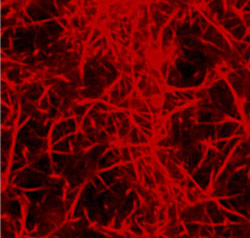The Attraction of Like Charges

Biochemists have known for many years that to get large charged molecules called polyelectrolytes to snuggle up, ions in the solution are essential. The ions must be oppositely charged from the molecules to nullify their repulsion, but the amount of charge per ion depends on the polyelectrolyte. Some require triply-charged (trivalent) ions, others doubly-charged (divalent), but singly-charged (monovalent) ions never work. What’s more, the size of the ion also matters. A better understanding of polyelectrolyte-ion interactions could lead to new treatments for diseases that involve unhealthy clumping of proteins, such as cystic fibrosis. The problem is also relevant to sludge treatment, where engineers try to aggregate impurities into clumps, and to time-release drug schemes that use ions to control the structure of large biological molecules bearing medications.
Gerard Wong of the University of Illinois at Urbana-Champaign and his colleagues addressed the ion size effect by using a small molecule called diamine, which is shaped like a dumbbell and can be lengthened in increments. It consists of two positively charged groups connected by one to four carbon atoms. When the team tested each of the four sizes in solution with a rod-shaped virus called M13 as the polyelectrolyte, only the shortest diamine molecules–just 0.29 nanometers across–caused clumping.
The team realized that 0.29 nanometers is close to an important length scale: If the M13 surface is viewed as a continuous sheet of charge, there is a range beyond which the charged exterior is “screened” by the surrounding water and ions and not noticeable by other charges floating at some distance away. According to Wong and his colleagues, if the diamine dumbbells are longer than this distance–called the Gouy-Chapman length, or lambda–they act more like pairs of weaker monovalent ions than like stronger divalents.
The researchers imagine that one end of a diamine can neutralize a patch of the virus’s negatively charged surface. Then the other end can give the region a positive charge that will attract another virus wandering close by. But if the diamine is too large, only one end is effectively within the patch. Lambda determines the patch size that matters, and it can be calculated for many polyelectrolytes. Using this formulation, the researchers correctly predicted which of three large biomolecules would clump in the presence of divalent ions.
According to Andrea Liu of the University of California at Los Angeles, the team “presents a beautiful experiment to sort out some of the questions that haven’t been adequately addressed from a theoretical point of view.” Coauthor Jay Tang of Brown University in Providence, Rhode Island, says the next step is developing a detailed model for polyelectrolyte behavior under all conditions. “That’s our Holy Grail,” he laughs. Wong emphasizes that “in terms of figuring this problem out, this is more a beginning than an end.”
–Kim Krieger
Kim Krieger is a freelance science writer in Norwalk, Connecticut.


